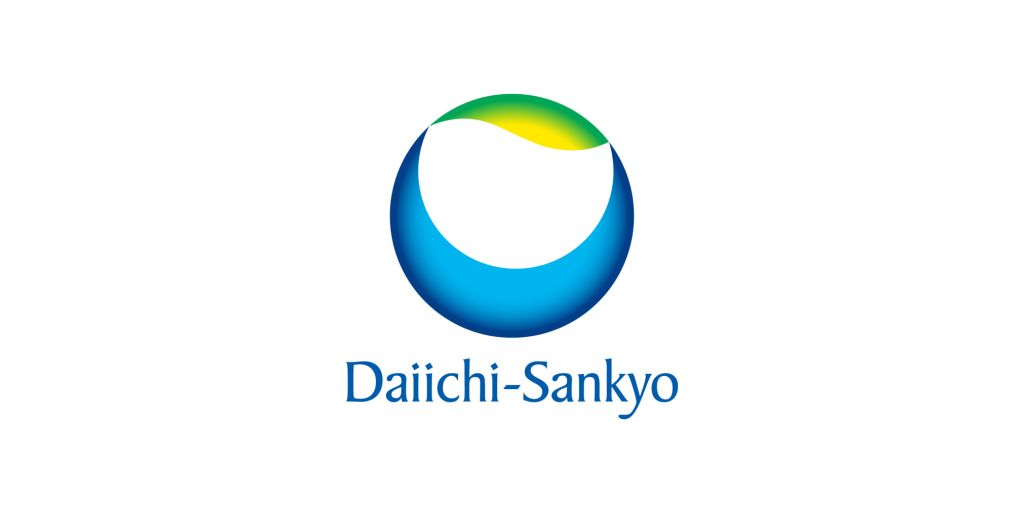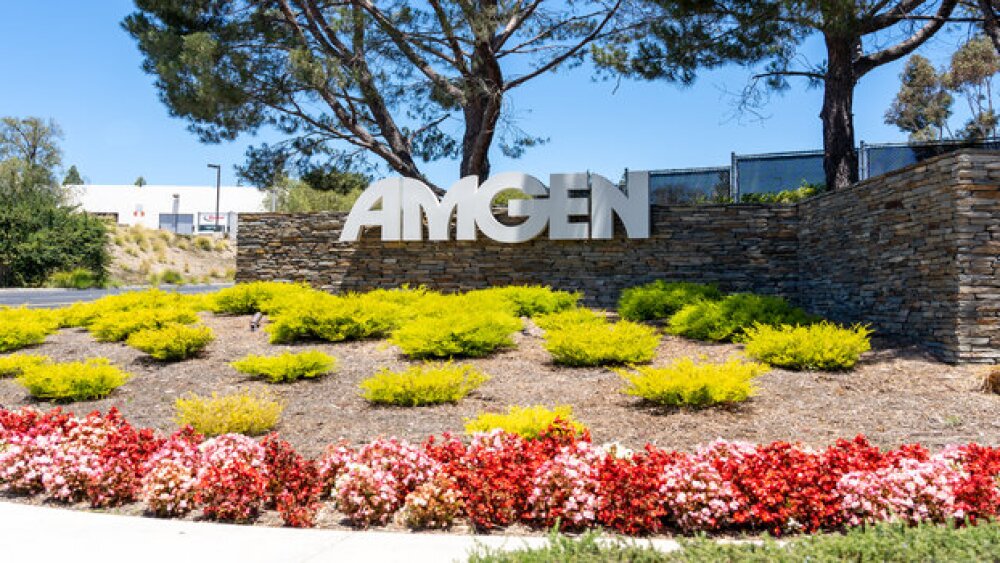- Based on DESTINY-Breast06 phase 3 trial which demonstrated a statistically significant and clinically meaningful progression-free survival benefit for ENHERTU
- If approved, Daiichi Sankyo and AstraZeneca’s ENHERTU will be the first HER2 directed therapy and antibody drug conjugate for patients prior to receiving chemotherapy for metastatic breast cancer
TOKYO & BASKING RIDGE, N.J.--(BUSINESS WIRE)--Daiichi Sankyo (TSE: 4568) and AstraZeneca’s (LSE/STO/Nasdaq: AZN) supplemental Biologics License Application (sBLA) for ENHERTU® (fam-trastuzumab deruxtecan-nxki) has been accepted and granted Priority Review in the U.S. for the treatment of adult patients with unresectable or metastatic HER2 low (IHC 1+ or IHC 2+/ISH-) or HER2 ultralow (IHC 0 with membrane staining) breast cancer who have received at least one endocrine therapy in the metastatic setting.
ENHERTU is a specifically engineered HER2 directed DXd antibody drug conjugate (ADC) discovered by Daiichi Sankyo and being jointly developed and commercialized by Daiichi Sankyo and AstraZeneca.
The U.S. Food and Drug Administration (FDA) grants Priority Review to applications for medicines that, if approved, would offer significant improvements over available treatment options by demonstrating safety or efficacy improvements, preventing serious conditions or enhancing patient compliance. The Prescription Drug User Fee Act (PDUFA) date, the FDA action date for their regulatory decision, is February 1, 2025. The Priority Review follows receipt of Breakthrough Therapy Designation granted by the FDA for ENHERTU based on data from the DESTINY-Breast06 phase 3 trial in August 2024.
Hormone receptor (HR) positive, HER2 negative is the most common breast cancer subtype, accounting for approximately 70% of all breast cancers.1 Despite being classified as HER2 negative, many of these tumors still carry some level of HER2 expression.2 It is estimated that up to 85% to 90% of tumors historically classified as HR positive, HER2 negative, may be HER2 low or HER2 ultralow.3,4
The sBLA is based on data from DESTINY-Breast06 presented as a late-breaking oral session at the 2024 American Society of Clinical Oncology (#ASCO24) Annual Meeting and recently published in The New England Journal of Medicine. In the overall trial population, ENHERTU reduced the risk of disease progression or death by 37% by blinded independent central review (BICR) versus chemotherapy (hazard ratio [HR] 0.63; 95% confidence interval [CI]: 0.53-0.75; p<0.0001). Median progression-free survival (PFS) was 13.2 months with ENHERTU compared to 8.1 months with chemotherapy.
Results were consistent in patients with HER2 low expression and HER2 ultralow expression. In the primary endpoint analysis of patients with HR positive, HER2 low metastatic breast cancer, median PFS was 13.2 months in the ENHERTU arm compared to 8.1 months in the chemotherapy arm (HR 0.62; 95% CI: 0.51-0.74; p<0.0001), as assessed by BICR. In a prespecified exploratory analysis of patients with HER2 ultralow expression, ENHERTU showed a median PFS of 13.2 months versus 8.3 months, respectively (HR 0.78; 95% CI: 0.50-1.21).
The safety profile of ENHERTU in DESTINY-Breast06 was consistent with previous breast cancer clinical trials with no new safety concerns identified. The most common grade 3 or higher treatment related treatment emergent adverse events (TEAEs) occurring in 5% or more of patients treated with ENHERTU were neutropenia (20.7%), leukopenia (6.9%) and anemia (5.8%). Interstitial lung disease (ILD) or pneumonitis occurred in 11.3% of patients treated with ENHERTU. The majority of ILD or pneumonitis events were low grade (grade 1 [n=7; 1.6%] or grade 2 [n=36; 8.3%]). There were three grade 3 ILD events (0.7%), zero grade 4 events and three grade 5 events (0.7%) as determined by an independent adjudication committee.
“This Priority Review highlights the potential to expand the existing indication of ENHERTU in HER2 low metastatic breast cancer to include use in an earlier disease setting as well as in a broader patient population that includes HER2 ultralow,” said Ken Takeshita, MD, Global Head, R&D, Daiichi Sankyo. “We look forward to working closely with the FDA with the goal of bringing ENHERTU to more patients as quickly as possible.”
“While endocrine therapies are widely used in the initial treatment of HR positive metastatic breast cancer, most patients see limited benefit with additional lines of treatment and subsequent chemotherapy is associated with poor response rates and outcomes,” said Susan Galbraith, MBBChir, PhD, Executive Vice President, Oncology R&D, AstraZeneca. “The results from DESTINY-Breast06 show that ENHERTU has the potential to evolve the current HR positive treatment landscape and become the first targeted treatment for patients with HER2 low or HER2 ultralow expression following endocrine therapy.”
About DESTINY-Breast06
DESTINY-Breast06 is a global, randomized, open-label, phase 3 trial evaluating the efficacy and safety of ENHERTU (5.4 mg/kg) versus investigator’s choice of chemotherapy (capecitabine, paclitaxel or nab paclitaxel) in patients with HR positive, HER2 low (IHC 1+ or IHC 2+/ISH-) or HER2 ultralow (defined as IHC 0 with membrane staining [IHC >0 <1+]) advanced or metastatic breast cancer. Patients in the trial had no prior chemotherapy for advanced or metastatic disease and received at least two lines of prior endocrine therapy in the metastatic setting. Patients also were eligible if they had received one prior line of endocrine therapy combined with a CDK4/6 inhibitor in the metastatic setting and experienced disease progression within six months of starting first-line treatment or received endocrine therapy as an adjuvant treatment and experienced disease recurrence within 24 months.
The primary endpoint of DESTINY-Breast06 is PFS in the HR positive, HER2 low patient population as measured by BICR. Key secondary endpoints include PFS by BICR in the overall trial population (HER2 low and HER2 ultralow), overall survival (OS) in patients in the HER2 low patient population and OS in the overall trial population. Other secondary endpoints include objective response rate, duration of response, time to first subsequent treatment or death, time to second subsequent treatment or death and safety. Analysis of the HER2 ultralow subgroup was not powered to demonstrate statistical significance.
DESTINY-Breast06 enrolled 866 patients (n=713 for HER2 low and n=153 for HER2 ultralow) at multiple sites in Asia, Europe, North America, Oceania and South America. For more information about the trial, visit ClinicalTrials.gov.
About Breast Cancer and HER2 Expression
Breast cancer is the second most common cancer and one of the leading causes of cancer-related deaths worldwide.5 More than two million breast cancer cases were diagnosed in 2022 with more than 665,000 deaths globally.5 In the U.S., more than 300,000 cases of breast cancer are diagnosed annually.6 While survival rates are high for those diagnosed with early breast cancer, only about 30% of patients diagnosed with or who progress to metastatic disease are expected to live five years following diagnosis.1
HR positive, HER2 negative is the most common breast cancer subtype, accounting for approximately 70% of all breast cancers.1 HER2 is a tyrosine kinase receptor growth-promoting protein expressed on the surface of many types of tumors, including breast cancer.7 Patients with high levels of HER2 expression (IHC 3+ or IHC2+/ISH+) are classified as HER2 positive and treated with HER2 targeted therapies, representing approximately 15 to 20% percent of all breast cancers.8 Historically, tumors that were not classified as HER2 positive were classified as HER2 negative, despite the fact that many of these tumors still carry some level of HER2 expression.2 It is estimated that approximately 60% to 65% of HR positive, HER2 negative breast cancers are HER2 low and potentially an additional 25% may be HER2 ultralow.3,4
Endocrine therapies are widely given consecutively in the early lines of treatment for HR positive metastatic breast cancer. However, following two lines of endocrine therapy, further efficacy with additional endocrine treatment is often limited. 9 The current standard of care following endocrine therapy is chemotherapy, which is associated with poor response rates and outcomes.9,10,11,12
Prior to the approval of ENHERTU following chemotherapy in HER2 low metastatic breast cancer based on the DESTINY-Breast04 trial, there were no targeted therapies approved specifically for patients with HER2 low expression.13 There are no targeted therapies specifically approved for patients with HER2 ultralow expression.14
About ENHERTU
ENHERTU (trastuzumab deruxtecan; fam-trastuzumab deruxtecan-nxki in the U.S. only) is a HER2 directed ADC. Designed using Daiichi Sankyo’s proprietary DXd ADC Technology, ENHERTU is the lead ADC in the oncology portfolio of Daiichi Sankyo and the most advanced program in AstraZeneca’s ADC scientific platform. ENHERTU consists of a HER2 monoclonal antibody attached to a number of topoisomerase I inhibitor payloads (an exatecan derivative, DXd) via tetrapeptide-based cleavable linkers.
ENHERTU (5.4 mg/kg) is approved in more than 65 countries worldwide for the treatment of adult patients with unresectable or metastatic HER2 positive (IHC 3+ or in-situ hybridization (ISH)+) breast cancer who have received a prior anti-HER2-based regimen, either in the metastatic setting or in the neoadjuvant or adjuvant setting, and have developed disease recurrence during or within six months of completing therapy based on the results from the DESTINY-Breast03 trial.
ENHERTU (5.4 mg/kg) is approved in more than 65 countries worldwide for the treatment of adult patients with unresectable or metastatic HER2 low (IHC 1+ or IHC 2+/ISH-) breast cancer who have received a prior systemic therapy in the metastatic setting or developed disease recurrence during or within six months of completing adjuvant chemotherapy based on the results from the DESTINY-Breast04 trial.
ENHERTU (5.4 mg/kg) is approved in more than 45 countries worldwide for the treatment of adult patients with unresectable or metastatic NSCLC whose tumors have activating HER2 (ERBB2) mutations, as detected by a locally or regionally approved test, and who have received a prior systemic therapy based on the results from the DESTINY-Lung02 trial. Continued approval in the U.S. for this indication may be contingent upon verification and description of clinical benefit in a confirmatory trial.
ENHERTU (6.4 mg/kg) is approved in more than 45 countries worldwide for the treatment of adult patients with locally advanced or metastatic HER2 positive (IHC 3+ or IHC 2+/ISH+) gastric or gastroesophageal junction (GEJ) adenocarcinoma who have received a prior trastuzumab-based regimen based on the results from the DESTINY-Gastric01, DESTINY-Gastric02 and/or DESTINY-Gastric06 trials. Full approval in China for this indication will depend on whether a randomized controlled confirmatory clinical trial can demonstrate clinical benefit in this population.
ENHERTU (5.4 mg/kg) is approved in the U.S. for the treatment of adult patients with unresectable or metastatic HER2 positive (IHC 3+) solid tumors who have received prior systemic treatment and have no satisfactory alternative treatment options based on efficacy results from the DESTINY-PanTumor02, DESTINY-Lung01 and DESTINY-CRC02 trials. Continued approval for this indication in the U.S. may be contingent upon verification and description of clinical benefit in a confirmatory trial.
About the ENHERTU Clinical Development Program
A comprehensive global clinical development program is underway evaluating the efficacy and safety of ENHERTU monotherapy across multiple HER2 targetable cancers. Trials in combination with other anticancer treatments, such as immunotherapy, also are underway.
About the Daiichi Sankyo and AstraZeneca Collaboration
Daiichi Sankyo and AstraZeneca entered into a global collaboration to jointly develop and commercialize ENHERTU in March 2019 and datopotamab deruxtecan in July 2020, except in Japan where Daiichi Sankyo maintains exclusive rights for each ADC. Daiichi Sankyo is responsible for the manufacturing and supply of ENHERTU and datopotamab deruxtecan.
About the ADC Portfolio of Daiichi Sankyo
The Daiichi Sankyo ADC portfolio consists of seven ADCs in clinical development crafted from two distinct ADC technology platforms discovered in-house by Daiichi Sankyo.
The ADC platform furthest in clinical development is Daiichi Sankyo’s DXd ADC Technology where each ADC consists of a monoclonal antibody attached to a number of topoisomerase I inhibitor payloads (an exatecan derivative, DXd) via tetrapeptide-based cleavable linkers. The DXd ADC portfolio currently consists of ENHERTU, a HER2 directed ADC, and datopotamab deruxtecan (Dato-DXd), a TROP2 directed ADC, which are being jointly developed and commercialized globally with AstraZeneca. Patritumab deruxtecan (HER3-DXd), a HER3 directed ADC, ifinatamab deruxtecan (I-DXd), a B7-H3 directed ADC, and raludotatug deruxtecan (R-DXd), a CDH6 directed ADC, are being jointly developed and commercialized globally with Merck. DS-3939, a TA-MUC1 directed ADC, is being developed by Daiichi Sankyo.
The second Daiichi Sankyo ADC platform consists of a monoclonal antibody attached to a modified pyrrolobenzodiazepine (PBD) payload. DS-9606, a CLDN6 directed PBD ADC, is the first of several planned ADCs in clinical development utilizing this platform.
Datopotamab deruxtecan, ifinatamab deruxtecan, patritumab deruxtecan, raludotatug deruxtecan, DS-3939 and DS-9606 are investigational medicines that have not been approved for any indication in any country. Safety and efficacy have not been established.
ENHERTU U.S. Important Safety Information
Indications
ENHERTU is a HER2-directed antibody and topoisomerase inhibitor conjugate indicated for the treatment of adult patients with:
-
Unresectable or metastatic HER2-positive (IHC 3+ or ISH positive) breast cancer who have received a prior anti-HER2-based regimen either:
– In the metastatic setting, or
– In the neoadjuvant or adjuvant setting and have developed disease recurrence during or within six months of completing therapy -
Unresectable or metastatic HER2-low (IHC 1+ or IHC 2+/ISH-) breast cancer, as determined by an FDA-approved test, who have received a prior chemotherapy in the metastatic setting or developed disease recurrence during or within 6 months of completing adjuvant chemotherapy
-
Unresectable or metastatic non-small cell lung cancer (NSCLC) whose tumors have activating HER2 (ERBB2) mutations, as detected by an FDA-approved test, and who have received a prior systemic therapy
This indication is approved under accelerated approval based on objective response rate and duration of response. Continued approval for this indication may be contingent upon verification and description of clinical benefit in a confirmatory trial.
-
Locally advanced or metastatic HER2-positive (IHC 3+ or IHC 2+/ISH positive) gastric or gastroesophageal junction (GEJ) adenocarcinoma who have received a prior trastuzumab-based regimen
-
Unresectable or metastatic HER2-positive (IHC3+) solid tumors who have received prior systemic treatment and have no satisfactory alternative treatment options
This indication is approved under accelerated approval based on objective response rate and duration of response. Continued approval for this indication may be contingent upon verification and description of clinical benefit in a confirmatory trial.
WARNING: INTERSTITIAL LUNG DISEASE and EMBRYO-FETAL TOXICITY
|
Contraindications
None.
Warnings and Precautions
Interstitial Lung Disease / Pneumonitis
Severe, life-threatening, or fatal interstitial lung disease (ILD), including pneumonitis, can occur in patients treated with ENHERTU. A higher incidence of Grade 1 and 2 ILD/pneumonitis has been observed in patients with moderate renal impairment. Advise patients to immediately report cough, dyspnea, fever, and/or any new or worsening respiratory symptoms. Monitor patients for signs and symptoms of ILD. Promptly investigate evidence of ILD. Evaluate patients with suspected ILD by radiographic imaging. Consider consultation with a pulmonologist. For asymptomatic ILD/pneumonitis (Grade 1), interrupt ENHERTU until resolved to Grade 0, then if resolved in ≤28 days from date of onset, maintain dose. If resolved in >28 days from date of onset, reduce dose one level. Consider corticosteroid treatment as soon as ILD/pneumonitis is suspected (e.g., ≥0.5 mg/kg/day prednisolone or equivalent). For symptomatic ILD/pneumonitis (Grade 2 or greater), permanently discontinue ENHERTU. Promptly initiate systemic corticosteroid treatment as soon as ILD/pneumonitis is suspected (e.g., ≥1 mg/kg/day prednisolone or equivalent) and continue for at least 14 days followed by gradual taper for at least 4 weeks.
HER2-Positive or HER2-Low Metastatic Breast Cancer, HER2-Mutant NSCLC, and Solid Tumors (Including IHC 3+) (5.4 mg/kg)
In patients with metastatic breast cancer, HER2-mutant NSCLC, and other solid tumors treated with ENHERTU 5.4 mg/kg, ILD occurred in 12% of patients. Median time to first onset was 5.5 months (range: 0.9 to 31.5). Fatal outcomes due to ILD and/or pneumonitis occurred in 1.0% of patients treated with ENHERTU.
HER2-Positive Locally Advanced or Metastatic Gastric Cancer (6.4 mg/kg)
In patients with locally advanced or metastatic HER2-positive gastric or GEJ adenocarcinoma treated with ENHERTU 6.4 mg/kg, ILD occurred in 10% of patients. Median time to first onset was 2.8 months (range: 1.2 to 21).
Neutropenia
Severe neutropenia, including febrile neutropenia, can occur in patients treated with ENHERTU. Monitor complete blood counts prior to initiation of ENHERTU and prior to each dose, and as clinically indicated. For Grade 3 neutropenia (Absolute Neutrophil Count [ANC] <1.0 to 0.5 x 109/L), interrupt ENHERTU until resolved to Grade 2 or less, then maintain dose. For Grade 4 neutropenia (ANC <0.5 x 109/L), interrupt ENHERTU until resolved to Grade 2 or less, then reduce dose by one level. For febrile neutropenia (ANC <1.0 x 109/L and temperature >38.3º C or a sustained temperature of ≥38º C for more than 1 hour), interrupt ENHERTU until resolved, then reduce dose by one level.
HER2-Positive or HER2-Low Metastatic Breast Cancer, HER2-Mutant NSCLC, and Solid Tumors (Including IHC 3+) (5.4 mg/kg)
In patients with metastatic breast cancer, HER2-mutant NSCLC, and other solid tumors treated with ENHERTU 5.4 mg/kg, a decrease in neutrophil count was reported in 63% of patients. Seventeen percent had Grade 3 or 4 decreased neutrophil count. Median time to first onset of decreased neutrophil count was 22 days (range: 2 to 939). Febrile neutropenia was reported in 1% of patients.
HER2-Positive Locally Advanced or Metastatic Gastric Cancer (6.4 mg/kg)
In patients with locally advanced or metastatic HER2-positive gastric or GEJ adenocarcinoma treated with ENHERTU 6.4 mg/kg, a decrease in neutrophil count was reported in 72% of patients. Fifty-one percent had Grade 3 or 4 decreased neutrophil count. Median time to first onset of decreased neutrophil count was 16 days (range: 4 to 187). Febrile neutropenia was reported in 4.8% of patients.
Left Ventricular Dysfunction
Patients treated with ENHERTU may be at increased risk of developing left ventricular dysfunction. Left ventricular ejection fraction (LVEF) decrease has been observed with anti-HER2 therapies, including ENHERTU. Assess LVEF prior to initiation of ENHERTU and at regular intervals during treatment as clinically indicated. Manage LVEF decrease through treatment interruption. When LVEF is >45% and absolute decrease from baseline is 10-20%, continue treatment with ENHERTU. When LVEF is 40-45% and absolute decrease from baseline is <10%, continue treatment with ENHERTU and repeat LVEF assessment within 3 weeks. When LVEF is 40-45% and absolute decrease from baseline is 10-20%, interrupt ENHERTU and repeat LVEF assessment within 3 weeks. If LVEF has not recovered to within 10% from baseline, permanently discontinue ENHERTU. If LVEF recovers to within 10% from baseline, resume treatment with ENHERTU at the same dose. When LVEF is <40% or absolute decrease from baseline is >20%, interrupt ENHERTU and repeat LVEF assessment within 3 weeks. If LVEF of <40% or absolute decrease from baseline of >20% is confirmed, permanently discontinue ENHERTU. Permanently discontinue ENHERTU in patients with symptomatic congestive heart failure. Treatment with ENHERTU has not been studied in patients with a history of clinically significant cardiac disease or LVEF <50% prior to initiation of treatment.
HER2-Positive or HER2-Low Metastatic Breast Cancer, HER2-Mutant NSCLC, and Solid Tumors (Including IHC 3+) (5.4 mg/kg)
In patients with metastatic breast cancer, HER2-mutant NSCLC, and other solid tumors treated with ENHERTU 5.4 mg/kg, LVEF decrease was reported in 3.8% of patients, of which 0.6% were Grade 3.
HER2-Positive Locally Advanced or Metastatic Gastric Cancer (6.4 mg/kg)
In patients with locally advanced or metastatic HER2-positive gastric or GEJ adenocarcinoma treated with ENHERTU 6.4 mg/kg, no clinical adverse events of heart failure were reported; however, on echocardiography, 8% were found to have asymptomatic Grade 2 decrease in LVEF.
Embryo-Fetal Toxicity
ENHERTU can cause fetal harm when administered to a pregnant woman. Advise patients of the potential risks to a fetus. Verify the pregnancy status of females of reproductive potential prior to the initiation of ENHERTU. Advise females of reproductive potential to use effective contraception during treatment and for 7 months after the last dose of ENHERTU. Advise male patients with female partners of reproductive potential to use effective contraception during treatment with ENHERTU and for 4 months after the last dose of ENHERTU.
Additional Dose Modifications
Thrombocytopenia
For Grade 3 thrombocytopenia (platelets <50 to 25 x 109/L) interrupt ENHERTU until resolved to Grade 1 or less, then maintain dose. For Grade 4 thrombocytopenia (platelets <25 x 109/L) interrupt ENHERTU until resolved to Grade 1 or less, then reduce dose by one level.
Adverse Reactions
HER2-Positive and HER2-Low Metastatic Breast Cancer, HER2-Mutant NSCLC, and Solid Tumors (Including IHC 3+) (5.4 mg/kg)
The pooled safety population reflects exposure to ENHERTU 5.4 mg/kg intravenously every 3 weeks in 1799 patients in Study DS8201-A-J101 (NCT02564900), DESTINY-Breast01, DESTINY-Breast02, DESTINY-Breast03, DESTINY-Breast04, DESTINY-Lung01, DESTINY-Lung02, DESTINY-CRC02, and DESTINY-PanTumor02. Among these patients, 65% were exposed for >6 months and 38% were exposed for >1 year.
Contacts
Media
Global/US:
Jennifer Brennan
Daiichi Sankyo, Inc.
jennifer.brennan@daiichisankyo.com
+1 908 900 3183 (mobile)
Japan:
Daiichi Sankyo Co., Ltd.
DS-PR@daiichisankyo.co.jp
Investor Relations:
DaiichiSankyoIR@daiichisankyo.co.jp






